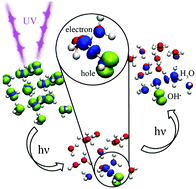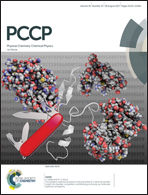The mechanism for the formation of OH radicals in condensed-phase water under ultraviolet irradiation†
Abstract
Irradiation on liquid water and ice by ultraviolet light in the range of 150–200 nm can create volatile OH radicals which react with other organic and inorganic molecules actively. However, the mechanism for OH radical formation in the condensed-phase water in this energy range is still unclear. To uncover this mechanism we studied the excited-state behaviors of ice using first-principles calculations based on many-body Green’s function theory. First, we showed that the long-wavelength optical absorption at the Urbach tail (190–300 nm) can be attributed to inherent hydroxide ions or transient structures formed in the autoionization process. Second, we revealed that creation of the OH radicals can be attributed to two mechanisms. Irradiation by the light at the Urbach tail excites an electron out of the hydroxide ion, leaving a neutral OH radical behind. By the light around 150 nm, OH radicals can be produced barrierlessly via direct water photolysis through concerted proton and electron transfer. Our results provide valuable insights into the excited-state dynamics of condensed-phase water, helping us understand in depth the photocatalytic reactions, radiation biology and chemistry.



 Please wait while we load your content...
Please wait while we load your content...